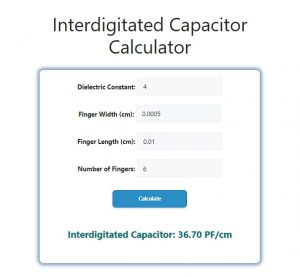About Interdigitated Capacitor Calculator (Formula)
Interdigitated capacitors (IDCs) are widely used in integrated circuits and microelectronic devices due to their compact design and efficient capacitance characteristics. The Interdigitated Capacitor Calculator simplifies the process of calculating the capacitance of these components by considering various factors such as the dielectric constant, width, length, and the number of fingers. This article explains how to use the calculator, provides a formula for capacitance, and answers common questions about interdigitated capacitors.
Formula
The formula for calculating the capacitance (C) of an interdigitated capacitor is:
C = (E + 1) / W * L * (((n – 3) * 0.089) + 0.10)
Where:
- C = Capacitance (in farads)
- E = Dielectric constant of the material
- W = Width of the fingers (in meters)
- L = Length of the fingers (in meters)
- n = Number of fingers
How to Use
- Determine the Dielectric Constant (E): Identify the dielectric material used in the capacitor and find its dielectric constant.
- Measure Finger Dimensions:
- Measure the width (W) of the capacitor fingers.
- Measure the length (L) of the capacitor fingers.
- Count the Number of Fingers (n): Determine how many fingers are present in the capacitor design.
- Input Values: Enter the values of E, W, L, and n into the calculator.
- Calculate Capacitance: Use the formula provided to compute the capacitance.
Example
Let’s consider a scenario where you have the following parameters for an interdigitated capacitor:
- Dielectric Constant (E) = 4.0
- Width of Fingers (W) = 0.0005 meters (0.5 mm)
- Length of Fingers (L) = 0.01 meters (10 mm)
- Number of Fingers (n) = 6
Step 1: Input the values into the formula:
C = (4.0 + 1) / 0.0005 * 0.01 * (((6 – 3) * 0.089) + 0.10)
Step 2: Calculate:
- First, calculate the term: (4.0 + 1) = 5.0
- Calculate the term: (((6 – 3) * 0.089) + 0.10) = (3 * 0.089) + 0.10 = 0.267 + 0.10 = 0.367
Now, substitute these values back into the formula:
C = 5.0 / 0.0005 * 0.01 * 0.367
C = 5.0 / 0.0005 * 0.00367
C = 10000 * 0.00367
C = 36.7 microfarads (μF)

FAQs
- What is an interdigitated capacitor?
An interdigitated capacitor is a type of capacitor design characterized by interleaved metal fingers that increase the effective surface area, allowing for higher capacitance in a compact space. - What materials are commonly used for the dielectric?
Common dielectric materials include silicon dioxide, polymer films, and ceramics, each with varying dielectric constants. - How does the number of fingers affect capacitance?
Increasing the number of fingers generally increases the capacitance, as it enhances the effective surface area available for charge storage. - What is the impact of finger width and length on capacitance?
Wider and longer fingers increase capacitance, as they provide more surface area for charge accumulation. - How accurate is the capacitance calculated using this formula?
The formula provides a theoretical capacitance value; actual capacitance can vary based on manufacturing tolerances and environmental conditions. - Can interdigitated capacitors be used in RF applications?
Yes, they are often used in RF circuits due to their low inductance and high Q factor. - What is the significance of the dielectric constant?
The dielectric constant indicates how well a material can store electrical energy in an electric field, impacting the overall capacitance. - How do temperature changes affect capacitance?
Temperature fluctuations can change the dielectric constant of materials, affecting the capacitance. - What applications utilize interdigitated capacitors?
They are commonly used in RF filters, oscillators, and as coupling capacitors in integrated circuits. - What are some design considerations for interdigitated capacitors?
Designers should consider the spacing between fingers, the substrate material, and the overall layout to optimize performance. - How can I improve the capacitance of my design?
Increase the number of fingers, widen the fingers, or use materials with higher dielectric constants. - Is it necessary to use a calculator for capacitance?
While it’s not mandatory, using a calculator helps ensure accurate and consistent capacitance values during design. - What software tools are available for simulating interdigitated capacitors?
Tools like COMSOL Multiphysics, ANSYS HFSS, and other electromagnetic simulation software can model and simulate these capacitors. - How do I choose the right dielectric material?
Consider factors like temperature stability, dielectric constant, loss tangent, and compatibility with your application. - Can I fabricate interdigitated capacitors myself?
Yes, with appropriate equipment and materials, interdigitated capacitors can be fabricated in a lab or workshop. - What is the effect of frequency on capacitance?
The capacitance of interdigitated capacitors can decrease at higher frequencies due to parasitic effects and dielectric losses. - What is the role of the substrate in interdigitated capacitors?
The substrate can affect capacitance and performance, with materials chosen based on electrical and thermal properties. - How does electric field strength impact capacitor performance?
High electric fields can lead to dielectric breakdown, reducing the reliability and lifespan of the capacitor. - What are parasitic capacitances, and how do they affect performance?
Parasitic capacitances arise from unintended connections and can affect circuit performance by introducing unwanted capacitance. - What is the recommended testing procedure for interdigitated capacitors?
Testing should include measuring capacitance under varying frequencies, voltages, and temperatures to understand performance characteristics.
Conclusion
The Interdigitated Capacitor Calculator is a valuable tool for anyone designing or working with interdigitated capacitors. By using the formula C = (E + 1) / W * L * (((n – 3) * 0.089) + 0.10), you can accurately determine the capacitance based on essential parameters. Understanding how to use this calculator and the factors affecting interdigitated capacitors will help you create more efficient and effective designs in your electronic applications.